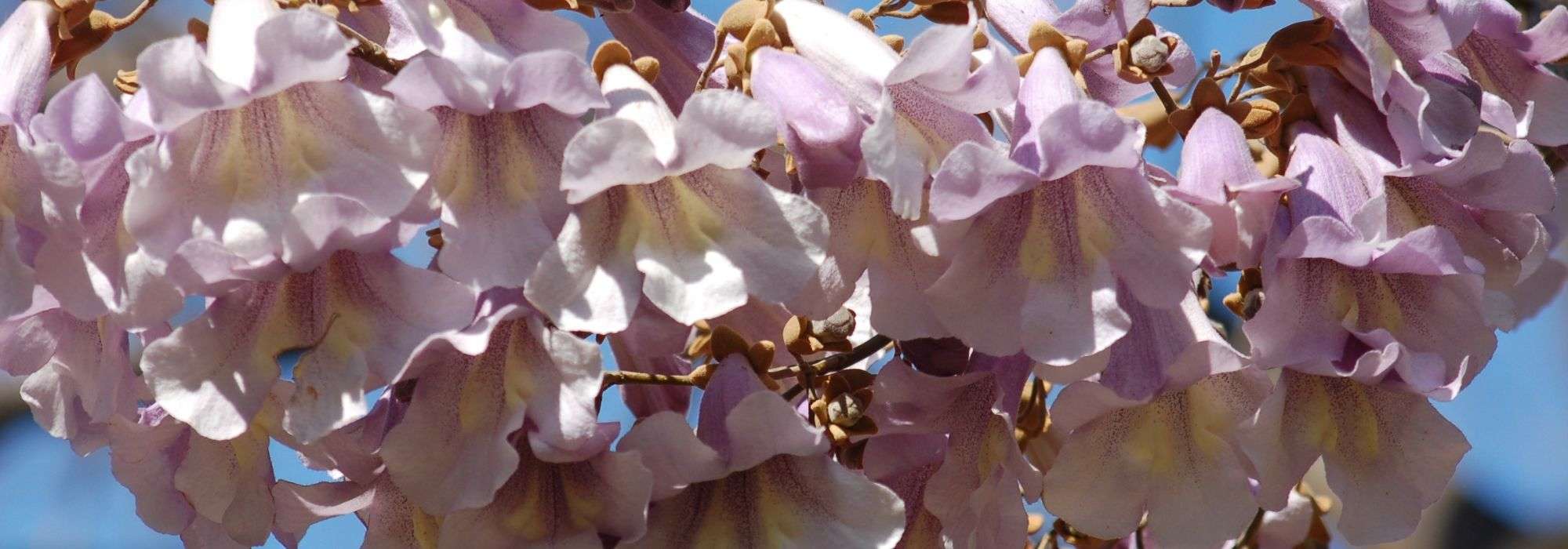
Paulownia, imperial tree: planting, cultivation and care
Contents
Paulownia in a nutshell
- Paulownia is a remarkable tree for its spring flowering, both spectacular and fragrant
- Its majestic, imposing foliage is ideal for providing welcome shade in the garden
- Imperial tree is mainly planted as a solitary specimen, but it can be coppiced to maintain a bush-like pruned size
- This fine tree prefers cool, rich and deep soils in full sun, but is vulnerable to severe frosts
- Resistant to pollution and parasitic pests, it has been widely planted in rows or in urban parks
A word from our expert
A Paulownia in flower is truly a regal presence. No, rather Imperial! It is, after all, its lovely nickname from Asia: the imperial tree. This charming tree is indeed native to the montane forests of China and Korea where it has, since time immemorial, held a role that is at once utilitarian, ornamental and symbolic.
Majestic, superb, magnificent… every glowing superlative can be used to describe this very beautiful, fast-growing tree. A magnificent spring flowering, both beautiful and fragrant, followed by a profusion of large heart-shaped leaves, all finished off by decorative fruiting in winter.
Plant imperial tree in rich, deep, cool but well-drained soil. Its favoured exposure is full sun, although it will quite happily live and thrive in partial shade.
Remarkable shade tree, it is also much appreciated during the hottest hours of summer days. It has often been planted in towns, in avenues or in parks, because it resists pollution, poor pruning, pests… The only thing that causes it some concern is severe winter cold, which can destroy flowers and young shoots. In cold climates, plant it in a part of the garden sheltered from heavy frost and cold winds.
Description and botany
Botanical data
- Latin name Paulownia sp.
- Family Paulowniaceae
- Common name Paulownia, Empress tree
- Flowering May to June
- Height 12 m
- Exposure sun or partial shade
- Soil type fresh, drained and deep
- Hardiness -15°C
Previously placed in the large family Scrophulariaceae or Scrofulariaceae, Paulownias now make up their own botanical family: the Paulowniaceae. The genus includes six species Paulownia catalpifolia, Paulownia kawakamii, Paulownia elongata, Paulownia X taiwaniana, Paulownia fortunei and the best-known Paulownia tomentosa (formerly called Paulownia imperialis) , nicknamed “Empress tree”.
All are very similar, but in cultivation almost exclusively Paulownia tomentosa and Paulownia fortunei are encountered, the latter differing from its cousin by flowering about three weeks earlier.
All these species originate from Asia, more precisely from mountains of China and Korea. They are pioneer trees that are among the first to grow on fallow or disturbed ground to “prepare the ground” for other plants. It is this pioneer character that has made Paulownia tomentosa an invasive species in some regions of North America. Later, in its natural environment, thanks to its work preparing the soil, other tree species will establish and grow quickly, then casting too much shade for it, which will prove fatal.
It was introduced long ago to Japan and is now cultivated worldwide thanks notably to its tolerance of pruning and pollution.
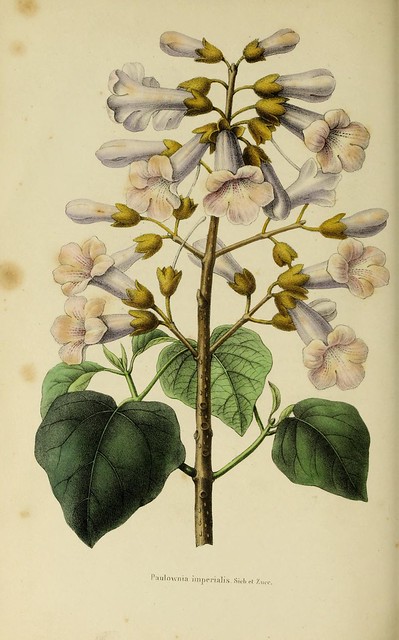
Paulownia tomentosa (syn. imperialis) – botanical illustration
Reaching up to twenty metres in its native range, Paulownia rarely exceeds twelve metres in our gardens. Which is already not bad… It is a majestic tree with a straight trunk and a spreading dome-shaped crown, ideal for providing shade in summer.
Bark is grey, smooth and slightly striate. Small orange vesicles can be seen on young trees.
Shoots are pubescent, that is covered in hairs, and bear on long petioles large deciduous opposite leaves up to 25 cm, heart-shaped with a silky underside. This trait gave the species name of P. tomentosa: “tomentose” meaning “silky“. Older shoots become hollow. So do not be surprised when pruning them!
Foliage turns yellow in autumn before falling quickly. From autumn, flower buds of a reddish colour can be seen on the shoots.
Flowering occurs in spring, generally before leaves appear. Hermaphrodite flowers, arranged in erect panicles at shoot tips, are violet and fragrant. The following fruits are oval, pointed capsules that remain decorative all winter. They open at maturity to release hundreds of winged seeds with a cottony appearance.
Sexual maturity of Paulownia is reached at about twenty-five years, but the tree lives only around a hundred years. Paulownia is a fast-growing species, gaining 4 to 7 m in just three years.
The tree has a fairly dense root system that helps reduce soil erosion and stabilise banks.

Paulownia tomentosa : flower buds, flowers, fruits and huge leaf
Main species and varieties

Paulownia tomentosa - Foxglove Tree
- Flowering time June, July
- Height at maturity 12 m

Paulownia fortunei Fast Blue Minfast - Foxglove Tree
- Flowering time June, July
- Height at maturity 8 m
Discover other Paulownia
View all →Available in 2 sizes
Available in 3 sizes
Available in 1 sizes
Available in 1 sizes
Available in 1 sizes
Available in 3 sizes
Planting Paulownia
Where to plant?
Paulownia thrives in rich, humus-bearing, fresh, well-drained and deep soil. Exposure in full sun suits it perfectly, though it can be grown in partial shade. To flower well, however, it needs long, warm summers, but not too dry.
As this tree already forms its flower buds in autumn and blooms early in the season, it is advisable to protect it from cold winds and severe frosts which can destroy the flowering.
It is indifferent to soil pH.
When to plant?
Paulownia is best planted in autumn or early spring. It is still possible to plant outside these periods, but watering will need to be monitored. And do not plant during heatwaves or frosts!
How to plant?
- Dip the pot of your new Paulownia into a bucket of water for a few minutes to re-moisten the rootball
- Dig a hole twice as deep and twice as wide as the rootball
- Add a handful or two of well-rotted compost to the bottom of the hole
- If your soil is heavy, you can add some gravel to improve drainage
- Loosen the rootball slightly to free the roots. Do this gently by hand or with a small fork to avoid damaging the roots
- Place the remaining rootball in the bottom of the hole, spreading the roots out well
- Fill the hole with the excavated soil, previously loosened
- Firm the soil gently around the tree with your hands (not with your feet!)
- Apply 10 litres of water at the base to reduce the risk of air pockets between the roots and the soil
- Apply a mulch to protect the young tree from drought or plant a few small groundcover plants at the base (creeping Bugle, sweet woodruff, Glechoma, Geranium macrorrhizum, …)
→ Learn more in our tutorial How to plant a Paulownia?
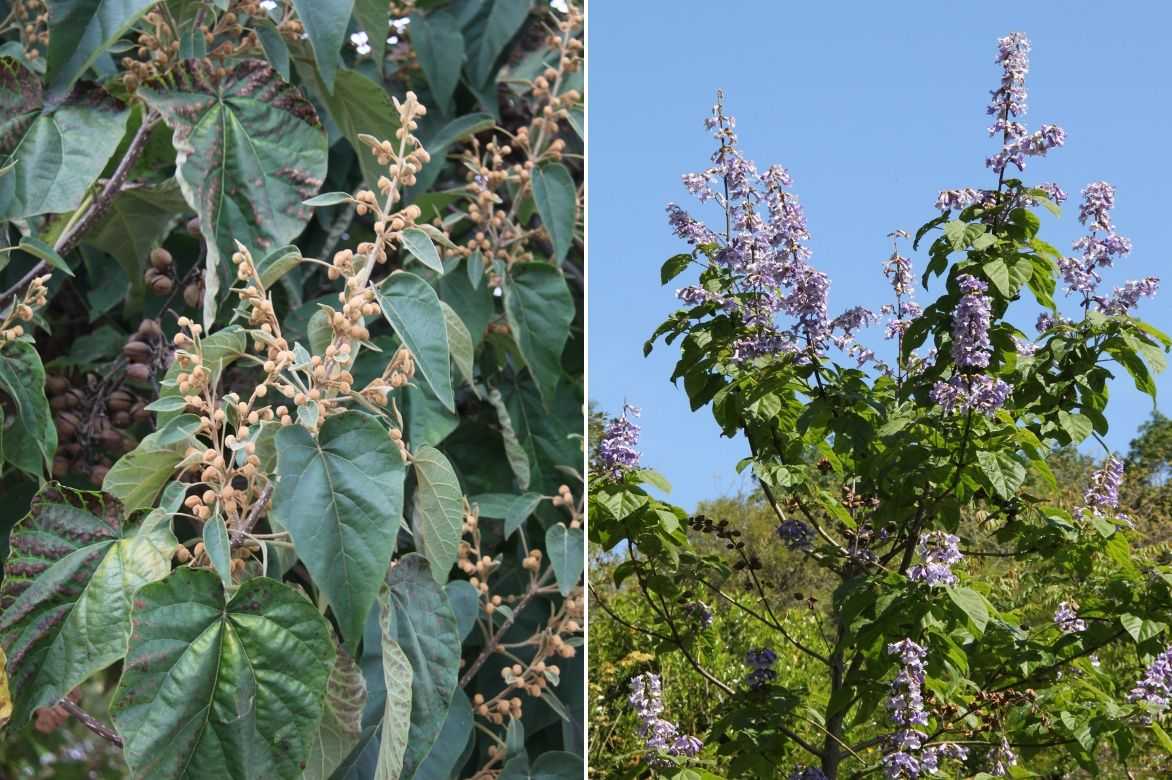
Read also
Catalpa: planting, pruning and careMaintenance, pruning and care
Protection against cold
Young shoots and floral buds can be damaged by late frosts or cold, dry wind. It is best to find a sheltered spot in the garden or to use horticultural fleece during the tree’s early years.
Pruning
Just before growth resumes, between February and the end of March, you can prune diseased or dead wood and some branches that slightly spoil the tree’s structure and habit. Always bear in mind that pruning large-diameter branches weakens trees. So be gentle with saw and pruning shear!
At the same time, if you wish to keep your Paulownia to a modest shrub size, you can prune all branches leaving only 2 or 3 buds at the base. The tree will then develop a bushy habit with even larger leaves, but, alas, you will not enjoy the flowering.
→ Learn more about pruning Paulownia in our tutorial !
Possible diseases
Paulownia is very resistant to pollution and parasitic organisms, but in very humid conditions, especially in summer, it can show some signs of disease: cankers, root rot, foliar spots, but above all powdery mildew should be watched for, although these remain relatively rare. In very poorly drained soil, an attack of Honey fungus (Armillaria), a wood-eating fungus that kills trees, can also occur.
→ Learn more about Paulownia diseases and parasitic organisms in our advice sheet !
Multiplication
By sowing
Paulownia, with its pioneering character, reproduces easily by sowing. Seeds need a period of cold to germinate. Therefore, either sow seeds outdoors in autumn, or place them in a tray in the fridge (5°C) for a few weeks before sowing in spring. Sow individually in pots or in rows outdoors, then pot up young seedlings later (keep the sturdiest specimens!) and plant out permanently only the following autumn.
Can’t find Paulownia seeds? We thought of you with Paulownia tomentosa seeds available to order online.
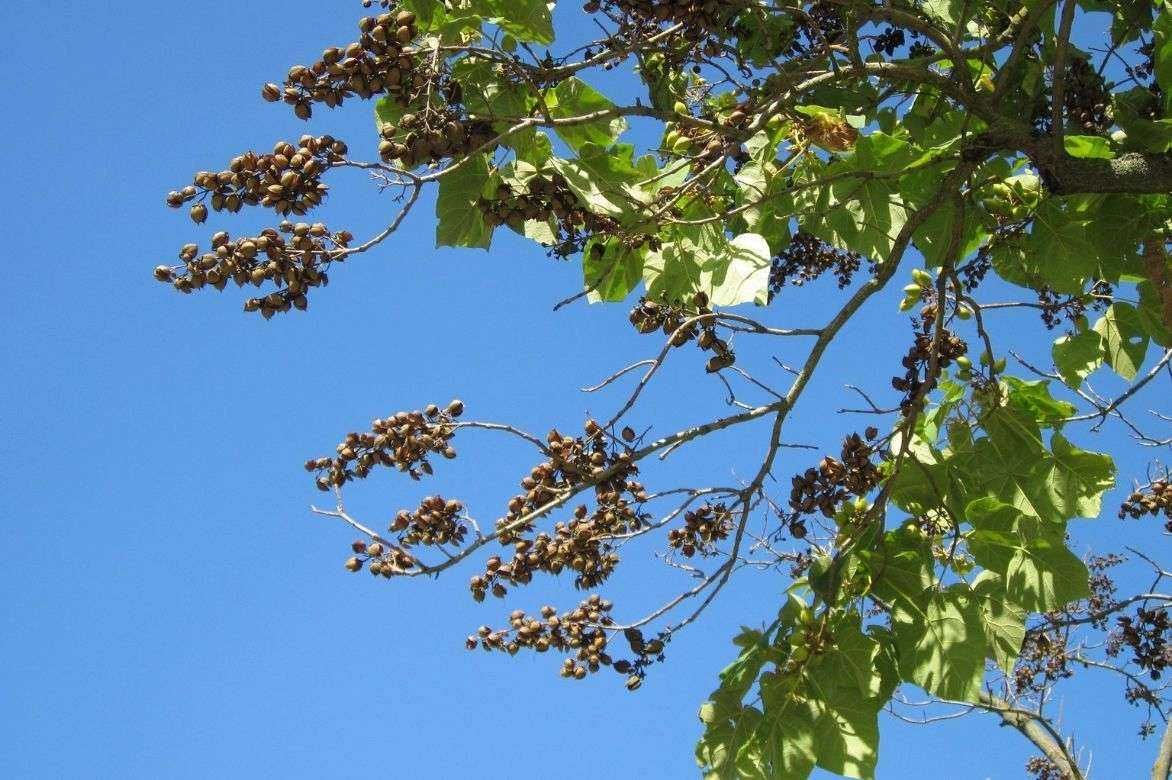
Separating suckers
Sometimes tree produces suckers. Simply dig carefully at base of tree to expose sucker. Cut root that still attaches it to mother plant then pot up for planting out in autumn.
→ To learn all about suckering of your favourite bushes, read My bush is suckering: why? What should I do?
By cuttings
Propagation by cuttings of paulownia is carried out in autumn by root cuttings. Ideally find, by digging at base of tree, a root with rootlets. Place this piece of root on a mixture of sand and potting compost and keep warm (20°C) and in darkness. At start of spring, first leaves will appear; you can then pot up and wait until following autumn to plant out.
You can also take a cutting in summer of a young shoot about 10 cm long into a light growing medium (potting compost + sand) and keep it under cover. Place shoot, having first removed about two-thirds of leaves, into compost. Cover with a plastic bag or the bottom of a plastic bottle to retain heat and humidity. First new leaves should appear quickly, a sign of successful strike. Plant out only in spring or the following autumn.
Some people successfully root any cutting in water! So why not try: place a young shoot in a vase filled with water with a piece of charcoal (to prevent rot; otherwise change water every two days). As soon as first small roots appear, pot up the seedling into a pot and a light growing medium (potting compost + sand). Do not let roots overdevelop, as they will be too fragile to grow later. You can plant out in spring or the following autumn.
→ Learn more in Alexandra’s tutorial: How to propagate Paulownia?
Companion planting Paulownia in the garden
A grove of bushes with spring flowering
Paulownia tomentosa produces purple flowers in April. Ideally pair it with a lower bush in a tone that responds to it, such as this uncommon Syringa x persica var. laciniata with lilac flowers and beautiful laciniate foliage. To contrast with the violet, try yellow and orange flowers, such as this charming but, sadly, very rarely planted Weigela middendorffiana, a small weigela with lovely pale yellow to amber flowers. Pair it with a a Forsythia koreana ‘Kumsun’, a very small, hardy forsythia that flowers bright yellow in spring, whose leaves have a granulated appearance thanks to fine cream-white veins. Complete the group with a a Cornus mas ‘Jolico’ which, besides giving a lovely yellow flowering in spring, will provide large edible red cornels in autumn, a colour that will match perfectly the flower buds of the Paulownia.
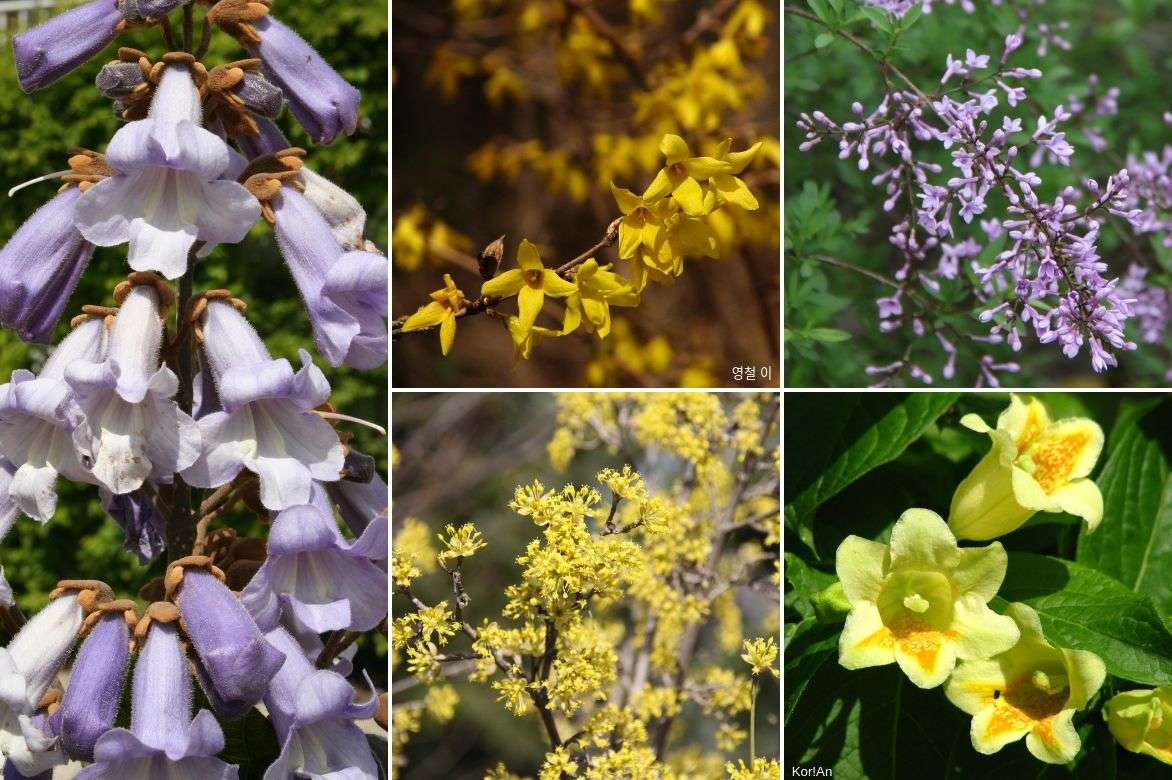
An example of an association in a grove: Paulownia tomentosa, Forsythia koreana ‘Kumsun’, Syringa persica ‘Laciniata’, Cornus mas ‘Jolico’ and Weigela middendorffiana
Pair your Paulownia with a beautiful climbing plant
If your Paulownia fortunei ‘Fast Blue’ is already tall and sturdy, you could echo the colour with a beautiful wisteria that will flower at the same time and in the same tone, such as Wisteria venusta ‘Okoyama’, a light, delicate wisteria that will not smother your Paulownia.
You can also play a strong contrast by training a liana that flowers yellow or even orange. In that case, and if your Paulownia is in a frost-protected situation, consider a lovely trumpet vine with orange and yellow flowers such as Campsis capreolata ‘Tangerine Beauty’.
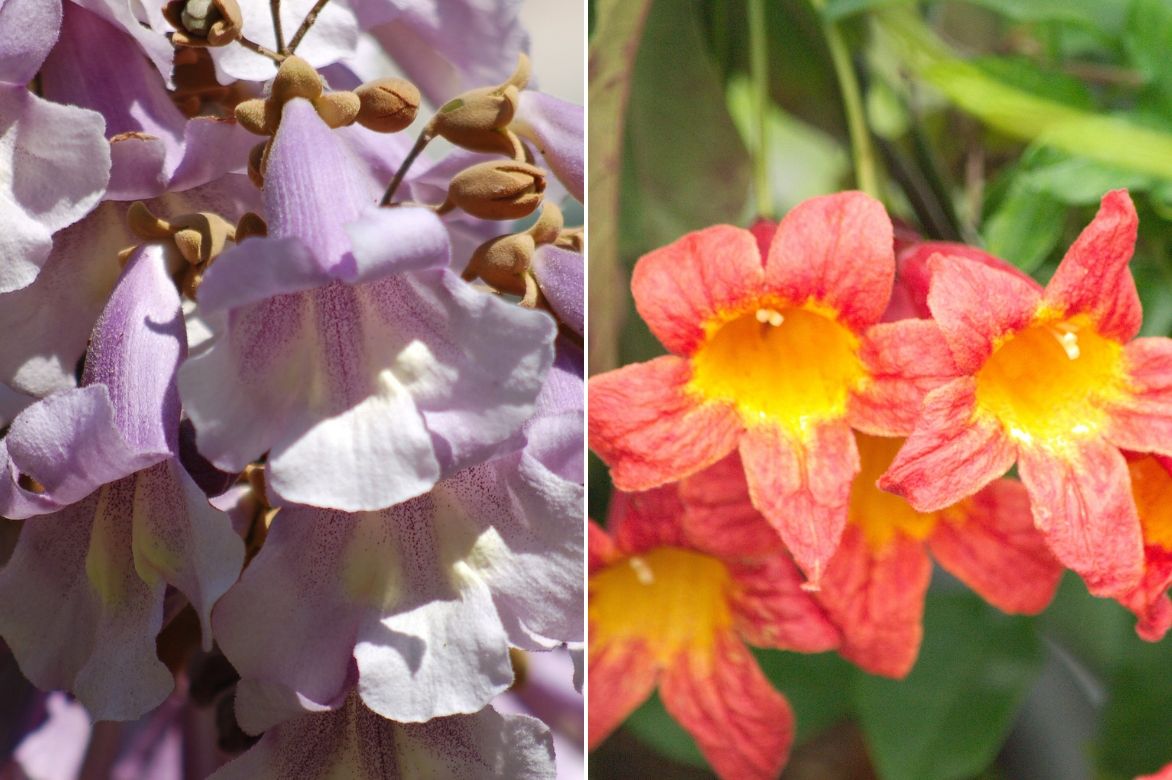
An example of an association with a climbing plant such as trumpet vine ‘Tangerine Beauty’
A mass of gigantic leaves in rich, moist soil
If you like exuberant, lush foliage, you can coppice your Paulownia tomentosa every year. It will then form enormous leaves! Accompany it with a Catalpa bignonioides ‘Aurea’, also cut back to coppice shoots, with magnificent golden-yellow foliage whose leaf shape will echo that of the Paulownia. Add a beautiful, imposing Astilboides tabularis with large foliage and airy flowering, as well as a Fatsia japonica, a timeless classic of lush gardens. If you have a little space left at the edge, you could plant some Hosta ‘Empress Wu’, huge hostas with slightly bluish foliage that will contrast beautifully with that of the catalpa.
→ Discover 5 other great ideas for pairing with Paulownia in our advice sheet!

An example of an association of lush foliage: Paulownia tomentosa, Fatsia japonica, Catalpa bignonioides ‘Aurea’, Astilboides tabularis and Hosta ‘Empress Wu’
Did you know?
- Name was given in honour of Anna Pavlowna, daughter of Tsar Paul I.
- Formerly in China, a Paulownia was planted at a girl’s birth. The tree grew and was eventually felled at her wedding so the wood could serve as dowry.
- From the 11th century, Paulownia, in association with the phoenix, has been used as a symbol on garments of the Chinese Imperial household.
- Vicomte de Cussy brought the first Paulownia seeds to the Jardin des Plantes in Paris in 1834. The tree flowered for the first time in 1842 and died in 1956… to be quickly replaced by a young specimen of the same species.
- Even today in Japan, Paulownia leaves represent an emblem that honours meritorious individuals, as well as the Japanese Prime Minister and his government.
- Paulownia is still used for its wood in China for cabinetmaking and luthiery.
- It is widely used in agroforestry, as the leaves are rich in nitrogen and can therefore be used as forage or as mulch. However, they compost rather poorly.
Useful resources
Discover our range of Paulownias in our online nursery.
Also discover 7 trees with unusual foliage
To choose your Paulownia, read Pascale’s tips
- Subscribe!
- Contents
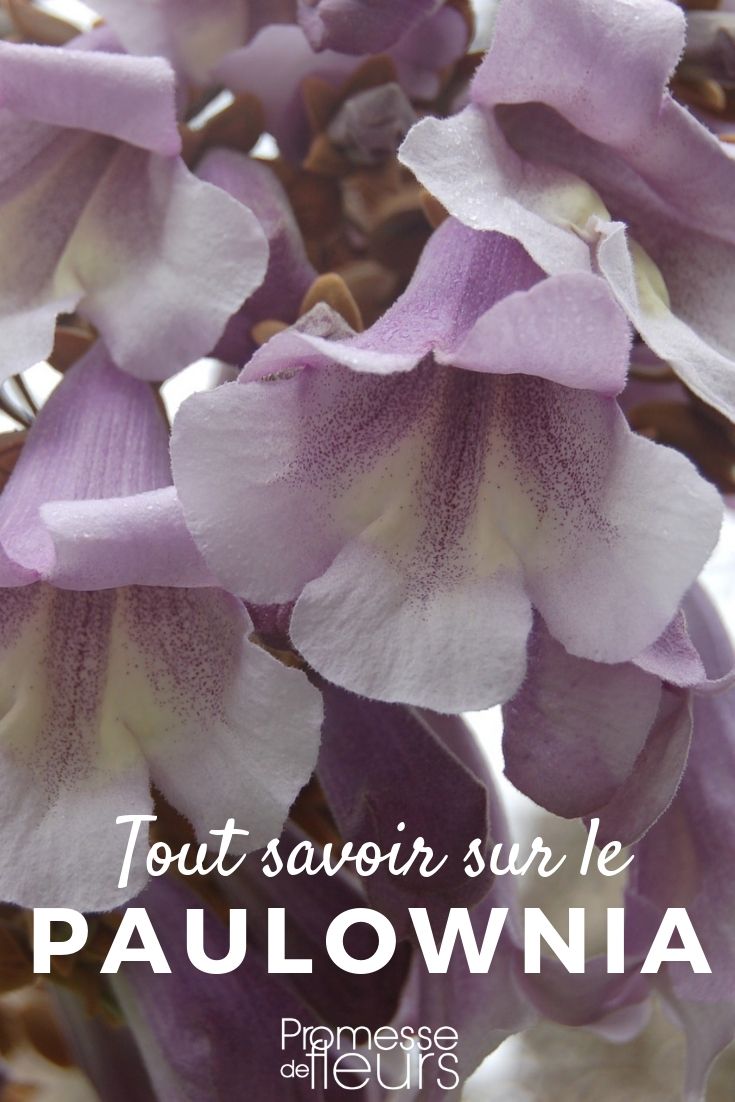
































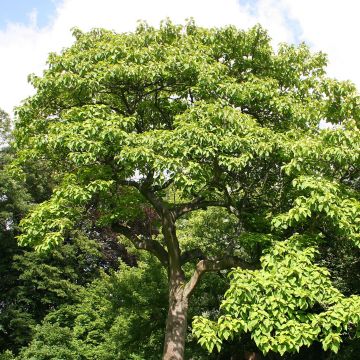


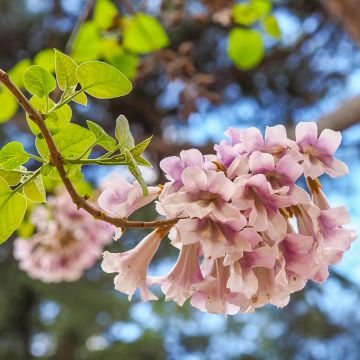

Comments